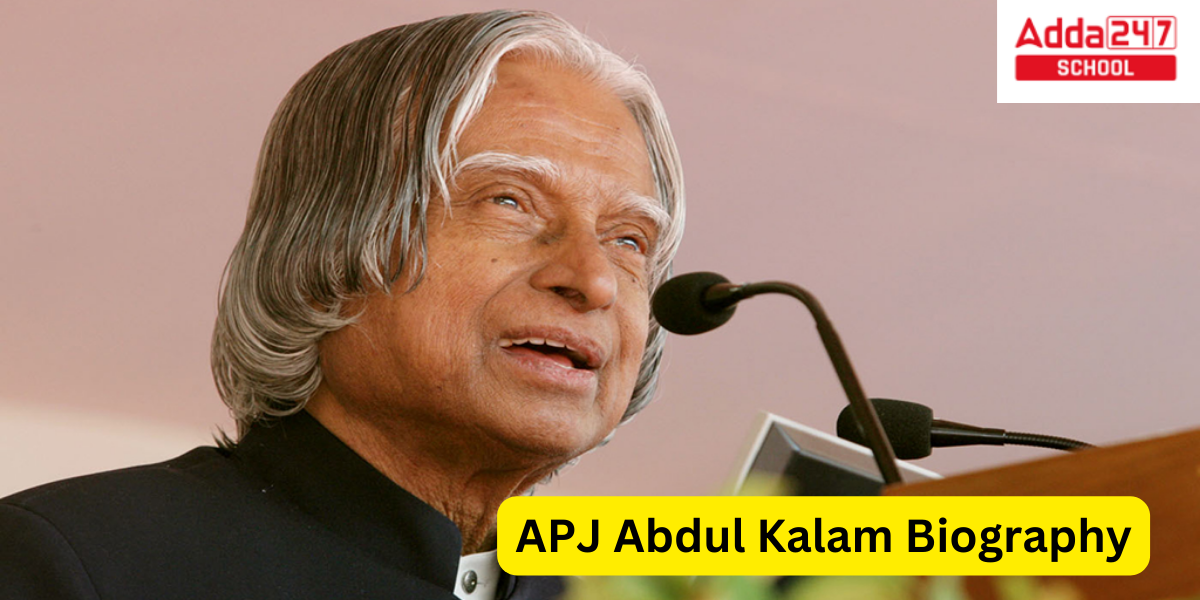APJ Abdul Kalam Biography
APJ Abdul Kalam Biography is very essential for students to know about our 11th President of India. APJ Abdul Kalam, also known as the “Missile Man of India,” was one of India’s most adored and revered figures. Kalam, who was born on October 15, 1931, in Rameswaram, Tamil Nadu, was a scientist, engineer, and politician who was instrumental in the creation of India’s missile and space programmes. APJ Abdul Kalam is well renowned for his humble demeanor, dedication to education and young, and strong love for his nation. Full APJ Abdul Kalam Biography is discussed next part of this article.
A. P. J. Abdul Kalam Childhood and Family
- APJ Abdul Kalam was born to a Tamil Muslim family in the small town of Rameswaram, located on an island off the southeastern coast of India.
- His father, Jainulabdeen, was a boat owner and imam at a local mosque, while his mother, Ashiamma, was a housewife. Kalam was the youngest of four siblings, and his family lived in relative poverty.
- Despite his humble beginnings, APJ Abdul Kalam was a bright student who excelled in mathematics and science. He studied physics at St. Joseph’s College in Tiruchirappalli and graduated in 1954.
- Afterward, he moved to Madras and studied aerospace engineering at the Madras Institute of Technology. In 1958, APJ Abdul Kalam earned a degree in aeronautical engineering and joined the Defence Research and Development Organisation (DRDO) as a scientist.
A. P. J. Abdul Kalam History
- Kalam’s career as a scientist began in earnest in 1965 when he joined the Indian Space Research Organisation (ISRO).
- In 1969, APJ Abdul Kalam was transferred to the Defence Research and Development Laboratory (DRDL) in Hyderabad, where he worked on the development of India’s first satellite launch vehicle (SLV-III).
- The SLV-III was a remarkable achievement for India, as it made India the sixth country in the world to have a satellite launch capability.
- Kalam’s biggest achievement, however, came in 1983 when he became the director of the DRDO’s Integrated Guided Missile Development Programme (IGMDP).
- Under his leadership, the programme developed five missile systems, including the Agni, Prithvi, Akash, Nag, and Trishul missiles.
- These missiles were significant for India as they gave the country a credible deterrent against its neighbors, particularly Pakistan and China.
- APJ Abdul Kalam was widely recognized as the “Missile Man of India” for his role in developing these missile systems.
- Kalam’s contributions to Indian science and technology did not end with the missile programme. APJ Abdul Kalam also played a critical role in the development of India’s nuclear program.
- In 1998, India conducted its first nuclear tests under Kalam’s guidance, making India a nuclear power.
- Aside from his scientific achievements, Kalam was also a devoted educator and mentor to young people.
- APJ Abdul Kalam believed that education was the key to unlocking India’s potential and that every child deserved the opportunity to receive an education.
- APJ Abdul Kalam frequently spoke at schools and universities, inspiring students with his words and encouraging them to pursue their dreams. Kalam also authored several books, including his autobiography “Wings of Fire,” which became a bestseller in India.
Political Career of Abdul Kalam
In 2002, APJ Abdul Kalam was elected as the President of India, succeeding K.R. Narayanan. He served as the President for five years, from 2002 to 2007, and was widely regarded as one of India’s most beloved presidents. During his presidency, Kalam focused on issues such as education, healthcare, and rural development. APJ Abdul Kalam frequently traveled across India, meeting with ordinary citizens and listening to their concerns. Kalam was known for his humble demeanor, his unassuming nature, and his deep love for his country.
Biography of APJ Abdul Kalam “The Missile Man of India”
APJ Abdul Kalam, also known as the Missile Man of India, was an inspirational figure who served as the 11th President of India. Born on October 15, 1931, in Rameswaram, Tamil Nadu, Kalam had a humble beginning and rose to become one of the most respected and admired personalities in India.
APJ Abdul Kalam was the youngest of four siblings and had a difficult childhood. His father was a boat owner and had to work hard to make ends meet. However, Kalam’s parents instilled in him a love for education, and he was a bright student from a young age. He completed his schooling from Schwartz Higher Secondary School and went on to study physics at St. Joseph’s College, Tiruchirappalli. He later completed his aeronautical engineering degree from the Madras Institute of Technology.
APJ Abdul Kalam Career as a Scientist
APJ Abdul Kalam began his career as a scientist in the 1960s in DRDO and worked for India’s civilian space program and military missile development program. APJ Abdul Kalam played a key role in India’s development of ballistic missile technology and was known for his contributions to the design and development of India’s first indigenous satellite launch vehicle, SLV-III.
- Kalam was unconvinced by his decision to work for the DRDO. In 1969, Kalam was assigned to ISRO as the project director for India’s first satellite vehicle launch.
- In July 1980, the satellite vehicle successfully launched the Rohini satellite into near-Earth orbit.
- Between the 1970s and 1990s, Kalam got government LV and SLV projects.
- He oversaw two projects, Project Devil and Project Valiant, which intended to create ballistic missiles using the technology developed by the successful SLV programme.
- Kalam persuaded Indira Gandhi to seek hidden money for these aerospace initiatives. In the 1980s, his studies and vast knowledge garnered him and the country significant honors.
- In 1992, Kalam was appointed as the defense minister’s scientific advisor, a position he held for five years until being promoted to the position of main scientific advisor to the government.
- His pivotal role in the country’s nuclear weapons tests in 1998 cemented India’s status as a nuclear power.
Kamal proposed a national plan dubbed Technology Vision 2020, which he described as an excellent method to alter India’s status from developing to developed in 20 years. - The plan envisioned the nation’s progress through the use of new technology, the expansion of healthcare facilities, and a focus on mass education.
Abdul Kalam Sir as 11th President of India
- Sir Kalam was the genuine 11th President of India. From July 25, 2002 until July 25, 2007, he served as President of the United States.
- Because of his tremendous contributions to the well-being of the people and the country, he was sometimes referred to as the people’s President.
- In a presidential election in 2002, he was elected with a big margin of victory. The nomination of the National Democratic Alliances for President was supported by the Samajwadi Party and the National Congress Party.
- He was bold and courageous enough to make and carry out tough, delicate, or contentious decisions. The most difficult Act he had to sign was the “office of profit.”
- NOTE – According to the English Settlement Act of 1701 in 1701, the “office of profit” means that no one who is a professional setup process under the royal family or who has an agreement with or is receiving a pension from the prince has the ability to work for the “House of Commons.” The royal family will have no influence over administrative conditions as a result of this.
- After saying his goodbyes at the office, he relocated and began his career as a visiting professor at the Indian Institute of Management in Shillong. He taught Aerospace Engineering at Anna University in Tamil Nadu.
Awards Received by APJ Abdul Kalam
In 1992, Kalam became the Chief Scientific Adviser to the Prime Minister of India and also served as the Secretary of the Defence Research and Development Organization (DRDO). He was awarded the Padma Bhushan in 1981 and the Padma Vibhushan in 1990 for his contributions to the Indian space program and the military.
APJ Abdul Kalam Biography: Interesting Facts
- Kalam was elected as the President of India in 2002, succeeding K.R. Narayanan.
- APJ Abdul Kalam was the first scientist to hold the position of President and was widely admired for his humble nature and his commitment to the welfare of the nation.
- During his tenure as President, Kalam was known for his efforts to promote education, particularly in rural areas, and for his advocacy of technology and innovation.
- APJ Abdul Kalam was a great visionary and believed that India could become a developed nation by 2020. He wrote several books on India’s development, including India 2020: A Vision for the New Millennium, and inspired a generation of young people to work towards making India a developed nation.
- APJ Abdul Kalam was also known for his humility and simplicity. He never sought power or wealth and remained grounded despite his many achievements.
- Kalam was often seen riding a bicycle or walking to his office and was known for his accessible and friendly nature.
- APJ Abdul Kalam once said, “I am not a politician, I am an ordinary citizen of India. But as President, I have a responsibility to inspire and motivate the people of this great nation.”
- Kalam was a role model for many young people in India and around the world. He believed in the power of education and urged young people to pursue their dreams and never give up.
- APJ Abdul Kalam once said, “You have to dream before your dreams can come true.”
- Kalam was also a great advocate of science and technology and believed that India could become a global leader in innovation.
- APJ Abdul Kalam believed that science and technology could be used to solve some of the world’s biggest problems, including poverty, hunger, and disease.
- Kalam’s contributions to India’s space program and military were recognized with numerous awards and honors, including the Bharat Ratna, India’s highest civilian award, in 1997.
- APJ Abdul Kalam was also awarded the King Charles II Medal by the Royal Society, UK, in 2007, and the Hoover Medal by the ASME Foundation, USA, in 2008.
APJ Abdul Kalam Biography for School Project
Early Life and Education: A.P.J. Abdul Kalam, known as the “Missile Man of India,” was born on October 15, 1931, in Rameswaram, Tamil Nadu. His full name was Avul Pakir Jainulabdeen Abdul Kalam. He came from a modest background, with his father, Jainulabdeen, being a boat owner, and his mother, Ashiamma, a housewife. Despite financial challenges, Kalam was a bright student, showing an early fascination with science and technology.
Kalam’s educational journey began at Schwartz Higher Secondary School in Ramanathapuram. He later attended St. Joseph’s College, Tiruchirappalli, where he graduated in physics in 1954. Driven by his passion for aerospace engineering, he enrolled at the Madras Institute of Technology (MIT). His dedication and hard work at MIT were evident, setting the foundation for his illustrious career.
Career in Science and Technology: After graduating from MIT in 1960, Kalam joined the Aeronautical Development Establishment of the Defence Research and Development Organisation (DRDO). His career took a significant turn when he moved to the Indian Space Research Organisation (ISRO) in 1969. At ISRO, Kalam played a crucial role in the development of India’s first satellite launch vehicle, the SLV-III, which successfully deployed the Rohini satellite in orbit in 1980. This achievement marked India’s entry into the space club.
Kalam’s work in the field of rocketry earned him the nickname “Missile Man of India.” He was pivotal in the development of ballistic missile technology, including the Agni and Prithvi missiles. His contributions were not limited to missile development; he also played a key role in India’s nuclear tests at Pokhran in 1998, which established India as a nuclear power.
Presidency and Later Life: In 2002, Kalam’s immense popularity and vision for India’s future led to his election as the 11th President of India. Known as the “People’s President,” he served from 2002 to 2007. During his presidency, Kalam emphasized the importance of education, youth empowerment, and rural development. He traveled extensively across the country, inspiring millions with his speeches and connecting with people, especially the youth.
After his presidency, Kalam continued to engage with the public as an educator and author. He was a visiting professor at several prestigious institutions, including the Indian Institute of Management (IIM) Shillong, IIM Ahmedabad, and IIM Indore. His books, such as “Wings of Fire,” “Ignited Minds,” and “India 2020,” are widely read and reflect his vision for India’s development.
Legacy and Impact: Dr. Kalam passed away on July 27, 2015, while delivering a lecture at IIM Shillong, doing what he loved most—interacting with students. His death was mourned across India, and he was accorded a state funeral.
A.P.J. Abdul Kalam’s life is a testament to the power of hard work, perseverance, and a passion for learning. He inspired a generation to dream big and work towards making those dreams a reality. His vision for India as a developed nation continues to guide and inspire policymakers, scientists, and young people.
Kalam’s legacy lives on through the numerous educational and scientific initiatives that bear his name and the countless lives he touched through his work and words. His humility, dedication, and visionary outlook make him a beloved figure in Indian history and a role model for generations to come.









 CBSE Admit Card 2026 for Private & R...
CBSE Admit Card 2026 for Private & R...
 AILET 2026 AIR 1: Check Full Toppers Lis...
AILET 2026 AIR 1: Check Full Toppers Lis...
 AILET Result 2026 OUT, How to Download S...
AILET Result 2026 OUT, How to Download S...














